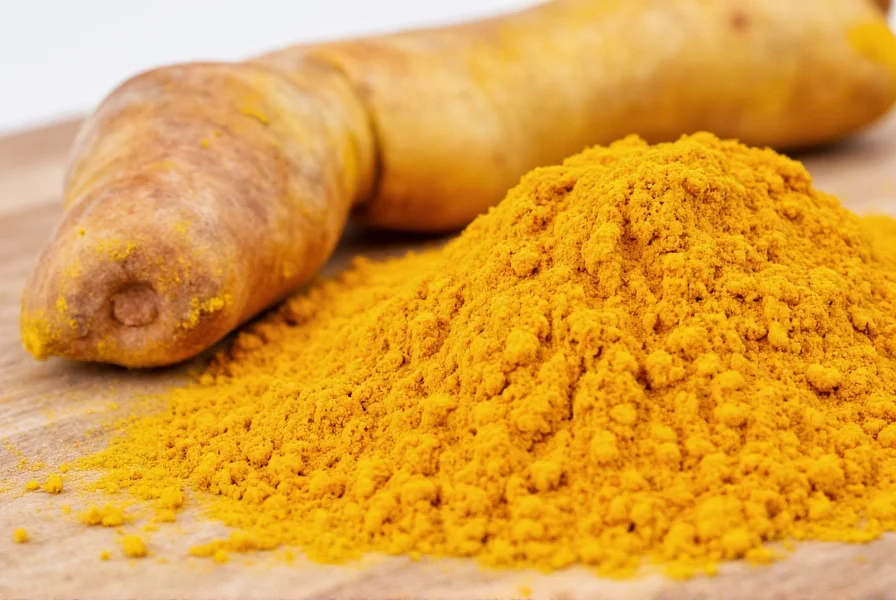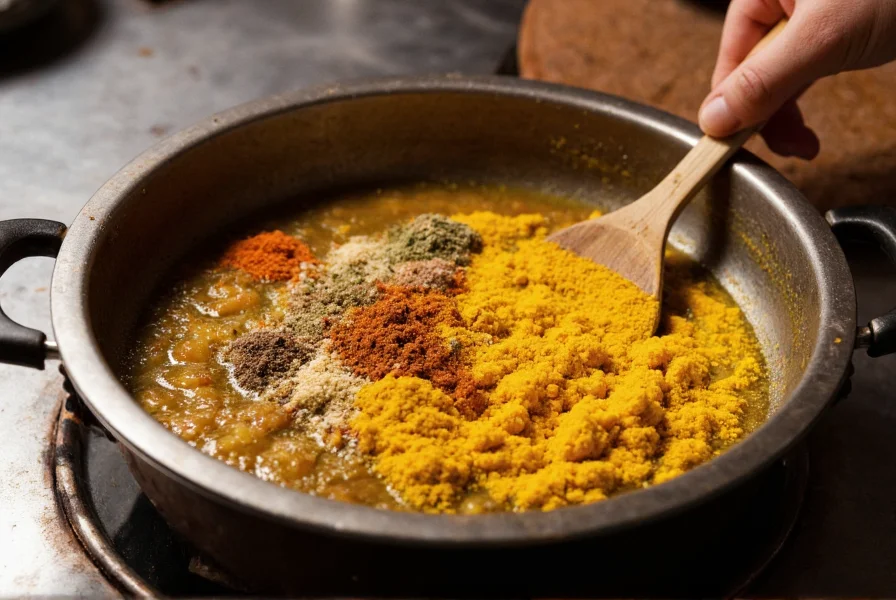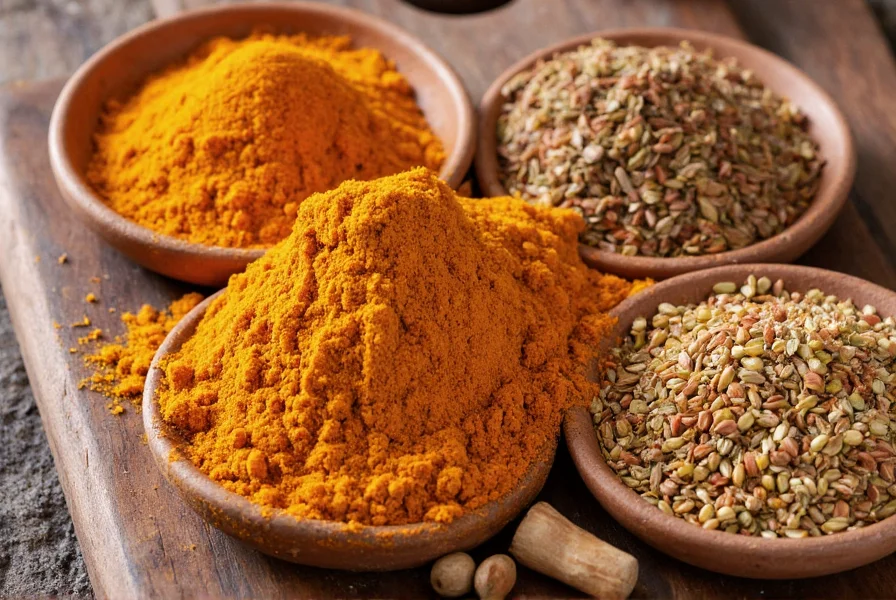These ancient spices have been used for thousands of years across Asian, Middle Eastern, and Mediterranean cultures not only for their distinctive flavors but also for their therapeutic properties. Modern research continues to validate many traditional uses while revealing new potential health applications.
The Individual Power of Each Spice
Turmeric: The Golden Healer
Turmeric (Curcuma longa), a member of the ginger family, gets its vibrant yellow color from curcuminoids, with curcumin being the most bioactive compound. This spice has been extensively studied for its anti-inflammatory and antioxidant properties. Research shows curcumin may help reduce inflammation markers in the body by inhibiting multiple molecules involved in inflammation pathways.
One challenge with turmeric is its low bioavailability. Curcumin isn't easily absorbed by the body, which is why traditional preparations often combine it with black pepper (containing piperine) or healthy fats to enhance absorption. The recommended effective dose in studies typically ranges from 500-2,000 mg of curcumin daily, though culinary use provides more modest but still beneficial amounts.

Cumin: The Digestive Aid
Cumin (Cuminum cyminum) is a flowering plant in the parsley family whose seeds have been used since ancient Egyptian times. Rich in iron, cumin supports healthy blood function and energy levels. Just one teaspoon of cumin seeds provides approximately 17% of the daily recommended iron intake.
Traditional medicine systems have long recognized cumin's digestive benefits. Scientific studies confirm that cumin may stimulate digestive enzymes, improve nutrient absorption, and potentially help regulate blood sugar levels. The primary active compounds in cumin include cuminaldehyde and thymol, which contribute to both its distinctive flavor and potential health effects.
Synergistic Health Benefits of Turmeric and Cumin Together
When combined, turmeric and cumin create complementary health effects that exceed their individual benefits. This powerful spice pairing demonstrates what researchers call "food synergy"—where the combined effect of foods is greater than the sum of their parts.
Studies examining traditional spice blends containing both turmeric and cumin have shown enhanced anti-inflammatory effects compared to either spice alone. The combination may particularly benefit digestive health, as cumin's carminative properties help reduce gas and bloating while turmeric's anti-inflammatory action soothes the digestive tract.
| Property | Turmeric | Cumin |
|---|---|---|
| Primary Active Compound | Curcumin | Cuminaldehyde |
| Key Health Benefits | Anti-inflammatory, antioxidant, may support joint health | Digestive aid, iron source, may support blood sugar regulation |
| Flavor Profile | Earthy, slightly bitter, warm | Warm, nutty, slightly peppery |
| Traditional Culinary Uses | Curries, golden milk, rice dishes | Spice blends, stews, roasted vegetables |
| Recommended Daily Amount (culinary) | 1/2-1 teaspoon | 1/2-1 teaspoon |
Optimal Culinary Applications for Turmeric and Cumin
Understanding how to properly use turmeric and cumin together can maximize both flavor and health benefits. These spices feature prominently in traditional spice blends across multiple cuisines:
- Indian cuisine: The foundation of many curry powders and garam masala variations
- Middle Eastern cooking: Essential in baharat and other regional spice mixes
- Mexican dishes: Found in some mole recipes and seasoning blends
- Mediterranean preparations: Used in falafel, hummus, and roasted vegetable dishes
For maximum flavor development, many chefs recommend dry-toasting whole cumin seeds before grinding them, then adding ground turmeric later in the cooking process. Turmeric's compounds can degrade with prolonged high heat, so adding it after cumin has released its oils preserves more of its beneficial properties.
When creating golden milk or other turmeric-based beverages, adding a pinch of cumin can enhance both the flavor complexity and digestive benefits. The traditional combination of these spices with black pepper and healthy fats (like coconut milk) creates the optimal environment for curcumin absorption.

Scientific Evidence Behind the Spice Pairing
While research specifically on the turmeric-cumin combination is still emerging, multiple studies support the individual benefits of each spice and suggest potential synergies:
A 2020 review published in the journal Nutrients examined traditional spice combinations and found that blends containing both turmeric and cumin demonstrated enhanced antioxidant activity compared to single spices. Another study in the Journal of Ethnopharmacology noted that traditional Ayurvedic formulations combining these spices showed improved efficacy for digestive disorders.
Researchers believe the combination may work through multiple mechanisms:
- Complementary anti-inflammatory pathways
- Enhanced bioavailability of active compounds
- Broader spectrum of antioxidant protection
- Improved digestive function supporting better nutrient absorption
It's important to note that while culinary use of these spices is generally safe, therapeutic doses should be discussed with a healthcare provider, especially for individuals taking blood thinners or managing specific health conditions.
Practical Tips for Maximizing Benefits
To get the most from turmeric and cumin in your daily diet:
- Store both spices in airtight containers away from light and heat to preserve potency
- Combine with black pepper (containing piperine) to increase curcumin absorption by up to 2,000%
- Add to dishes with healthy fats like olive oil, avocado, or coconut milk for better absorption of fat-soluble compounds
- Use freshly ground cumin seeds when possible for maximum flavor and potency
- Consider adding these spices to smoothies, soups, roasted vegetables, and grain dishes for regular consumption
When shopping for quality spices, look for vibrant color (deep yellow for turmeric, rich brown for cumin) and strong aroma. Organic options may reduce exposure to potential contaminants, though the most important factor is freshness, as spices lose potency over time.
Frequently Asked Questions
What's the best way to combine turmeric and cumin for maximum health benefits?
The optimal combination includes turmeric with black pepper and healthy fats. Try adding 1/2 teaspoon turmeric, 1/2 teaspoon cumin, a pinch of black pepper, and 1 teaspoon of coconut oil or olive oil to your dishes. This combination significantly enhances curcumin absorption while providing the digestive benefits of cumin.
Can I take turmeric and cumin supplements together?
While culinary amounts are generally safe, consult your healthcare provider before combining supplements. High-dose curcumin supplements may interact with certain medications. For most people, getting these compounds through food is the safest approach, providing balanced amounts with other beneficial compounds naturally present in the whole spices.
How much turmeric and cumin should I use daily for health benefits?
For culinary use, 1/2 to 1 teaspoon of each spice daily provides noticeable benefits without risk. Traditional diets in regions where these spices are staples often include 1-3 grams of turmeric and similar amounts of cumin daily. Remember that consistency matters more than large single doses—regular incorporation into your diet yields the best results.
Do turmeric and cumin help with inflammation?
Yes, both spices have demonstrated anti-inflammatory properties. Turmeric's curcumin inhibits multiple inflammatory pathways, while cumin contains compounds that may reduce inflammation markers. Research suggests their combination may provide broader anti-inflammatory effects than either spice alone, making them valuable components of an anti-inflammatory diet.
Can I use turmeric and cumin if I have digestive issues?
Most people with digestive concerns can benefit from this spice combination. Cumin has traditionally been used to support digestion, while turmeric may help soothe inflammation in the digestive tract. However, those with gallbladder issues or GERD should consult a healthcare provider, as turmeric may exacerbate these conditions in some individuals. Start with small amounts to assess tolerance.











 浙公网安备
33010002000092号
浙公网安备
33010002000092号 浙B2-20120091-4
浙B2-20120091-4